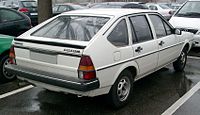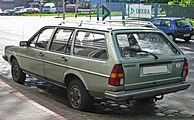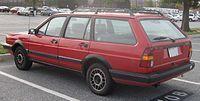VW Passat B2
| Volkswagen | |
|---|---|
|
VW Passat (1980–1985)
|
|
| Passat B2 | |
| Production period: | 1980-1988 |
| Class : | Middle class |
| Body versions : | Sedan , hatchback , station wagon |
| Engines: |
Otto engines : 1.3–2.2 liters (40–103 kW) Diesel engines : 1.6 liters (40–59 kW) |
| Length: | 4435-4540 mm |
| Width: | 1685 mm |
| Height: | 1385 mm |
| Wheelbase : | 2550 mm |
| Empty weight : | from 845 kg |
| Previous model | VW Passat B1 |
| successor | VW Passat B3 |
The Volkswagen Passat B2 is the second generation of the mid- range Passat from the manufacturer Volkswagen . It replaced the Passat B1 in October 1980 . In February 1981, the station wagon variant, the Passat Variant, which was particularly popular in Germany, and the three-door hatchback sedan came onto the market. In September 1981 VW provided the Passat with the better equipped notchback version Santana . In spring 1988, the Passat B2 was replaced by the Passat B3 in Germany .
Model history
General
The Passat B2 (internal type 32B) essentially followed the technical concept of the VW Passat B1 . The external dimensions of the second generation of the Passat have grown significantly compared to the previous B1: As a station wagon, it is almost 30 centimeters longer than its predecessor and seven centimeters wide. Another new feature was the torsion -beam rear axle with spring-damper units and "track-correcting" rubber bearings that became harder in the longitudinal direction under the influence of lateral forces.
In August 1982 Volkswagen presented a diesel engine with an exhaust gas turbocharger. In April 1984 the all-wheel drive Passat Variant Syncro was added.
Body styles
The most common variant is the five-door station wagon ( sales name Variant ). There was also the Passat three and five-door hatchbacks and the Santana notchback sedans.
The Passat and Santana (in the USA the Santana was sold under the name "Quantum") also differ on the front. The Passat has fog lights or decorative panels that create the impression of headlights next to the main headlights and the indicators in the bumper. The Santana has one-piece headlights. The indicators, generally with white cover glasses, are next to them in the fender corners.
Facelift
In January 1985, VW carried out a facelift on the Passat. The hallmarks of this revision include more voluminous bumpers that run around the corners to the wheel arches and a coarser ribbed front grille. The fog lights and the interior were also retouched and there were new taillights on the hatchback and a glued-in rear window instead of a rubber one. The three-door sedan was omitted. In addition, the Santana was renamed the Passat (notchback) and received its front.
Production ended on March 31, 1988, with the all-wheel drive variant (Syncro) rolling off the assembly line until July 1988.
With 3,345,248 in Germany and a total of over 4.5 million vehicles produced, the Passat B2 is a successfully sold car. The models sold in Germany were built in the VW plants in Emden and Brussels .
Engine variants and technology
At the start, the engine range consisted of the following units installed lengthways: three four-cylinder petrol engines with 1.3 liters (55 hp) or 1.6 liters (75 hp and 85 hp), a five-cylinder petrol engine with 1.9 liters (115 PS) and a 1.6-liter diesel with 54 PS. Initially, the Formula E (Economy) variant was also offered with the 75 hp 1.6-liter engine . In addition to the “4 + E transmission” with a long-geared 5th gear, it had aerodynamic measures to reduce air resistance and optimized tires with low rolling resistance . The stop-start system was intended to further reduce fuel consumption: a button was installed in the wiper lever to switch off the engine. If the accelerator pedal was pressed after the clutch was actuated, the engine started again.
The VW Passat B2 was available with a conventional four-speed gearbox or the “4 + E-gearbox” with fifth gear (E-gear), which was supposed to reduce fuel consumption. The fifth gear was translated as "gentle gear" longer than usual. The top speed was reached in fourth gear; on the other hand, when driving on the motorway in fifth gear, consumption fell due to the lower engine speed, which also resulted in a reduction in engine noise. The basic engines were VW designs; the engines with over 100 hp came from Audi.
Syncro
The all-wheel drive version (type 32B-299) was introduced in autumn 1984 under the name Syncro . It is based on the Quattro system from Audi and the Passat Variant Tetra study presented at the 1983 IAA .
The floor pan of the Passat syncro is designed differently from that of the front-wheel drive versions. The center tunnel was enlarged to make room for the cardan shaft . The spare wheel recess disappeared in the rear because space was needed for the tank that had been moved to the rear and the complex rear axle with subframe, trailing arm and differential mount.
The spare wheel, here only a narrow spare wheel for reasons of space , was now on the left side under a cover in the trunk. All four wheels were permanently driven via a lockable center differential , with a torque distribution of 50% at the front and 50% at the rear with the center differential unlocked. The rear differential was also lockable. The Syncro models were only available as a variant, initially exclusively with GT equipment and the 5-cylinder engines 2.0 l / 85 kW (115 PS) and 2.2 l / 88 kW (120 PS) with catalytic converter 1985 also in the basic version C with 1.8 l / 66 kW (90 PS) carburetor and with catalytic converter and petrol injection.
Special models
Various special models were offered that were based on basic equipment with a limited choice of colors and offered a large number of special equipment at a comparatively lower price.
Examples are Tramp, Trophy, Trend, TA-Passat, Topic, Carat, Arena.
Research vehicle IRVW II
The research vehicle IRVW II ("Integrated Research Volkswagen") was developed on the basis of the Passat B2 under Ulrich Seiffert and Ernst Fiala . It had a curb weight of 997 kg and a top speed of 160 km / h. Letting go of the accelerator switched off the 1.3-liter engine and the vehicle automatically switched to sailing . The engine was restarted automatically when the accelerator was pressed. Depending on the course of the road, up to half of the route could be covered by sailing. After sailing was not taken into account in the statutory provisions on consumption and taxation, the automatic engine shutdown did not go into series production. With average use, your additional costs for the new car would have been amortized after two years through saved petrol . After the second oil crisis , the Formula E concept stood for energy saving and expanded the equipment of the IRVW II . The green light with an upward arrow in the cockpit stood for the upshift recommendation. Ford used this indicator in series in the 2000s; today it is in almost every diesel with a manual transmission. In E-gear, the long-geared fifth gear newly built into manual transmissions at that time, a reduction in speed was achieved, but no higher speed on the plane, which was due to the motorization in connection with the headwind at this speed. An ecometer showed the consumption in liters per 100 km in E gear.
"Electronic" study
The "Electronic" study was presented on the occasion of the 1983 International Motor Show in Frankfurt. Features were the all-wheel drive with ABS, 2.2-l five-cylinder turbo engine with 147 kW (200 PS) from the Audi Urquattro, sports seats with lumbar support and belt retractor, electric headlight range control, stepless dimming, cruise control, heated windscreen washer nozzles and electric window lifters with automatic safety.
Export and foreign models
The Passat B2 was also popular abroad, with the Variant being sold in the USA as Volkswagen Quantum, in Mexico as Volkswagen Corsar and in Argentina as Volkswagen Carat. In Brazil, the Passat was sold as Santana or Quantum (Variant) (there was also the only two-door version of the Santana), but also with slight body modifications under the Ford brand as Ford Versailles (notchback) or Ford Royale (station wagon). The Ford Royale was also available as a two-door station wagon. Thus six different basic body shapes were produced for the B2. In China, the variant and notchback version was also produced as the Santana until December 2014 .
Over the years, changes were made to the technology and appearance of all versions manufactured in South America after 1992, so that in the end they resembled the B4, which was produced in Germany from the end of 1993. A version of the heavily modified Brazilian Santana with a longer wheelbase was also made in China, with the area between the B and C pillars lengthened. This version is called Santana 2000 (until February 2003), Santana 3000 (from March 2003) and Santana Vista (from the end of 2007). The model was produced until 2013 and then received a successor specially developed for the Chinese market .
Petrol engines
| model | Mixture formation | cylinder | Cubic capacity cm³ |
Max. Power kW (hp) at min -1 |
Max. Torque Nm at min -1 |
Motor ISIN letters |
catalyst | construction time | Remarks |
|---|---|---|---|---|---|---|---|---|---|
| 1.3 | Carburetor | 4th | 1272 | 40 (55) / 5800 | 90/3400 | FY | 10 / 1980-07 / 1983 | - | |
| 1.3 | Carburetor | 4th | 1272 | 44 (60) / 5800 | 95/3800 | FZ | - | 10 / 1980-07 / 1983 | Export models |
| 1.3 | Carburetor | 4th | 1296 | 44 (60) / 5600 | 100/3500 | EP | - | 08 / 1983-07 / 1986 | |
| 1.6 | Carburetor | 4th | 1588 | 48 (65) / 5000 | 115/3000 | WP | - | 10 / 1980-12 / 1981 | For countries with lower octane numbers |
| 1.6 | Carburetor | 4th | 1588 | 51 (70) / 5600 | 121/3000 | YY | - | 10 / 1980-07 / 1981 | For Austria |
| 1.6 | Carburetor | 4th | 1588 | 51 (70) / 5200 | 123/3200 | WVA | - | 08 / 1981-07 / 1983 | For Austria |
| 1.6 | Carburetor | 4th | 1588 | 55 (75) / 5600 | 119/3000 | WY | - | 11 / 1980-07 / 1983 | For Switzerland and Sweden |
| 1.6 | Carburetor | 4th | 1588 | 55 (75) / 5600 | 121/3200 | YN | - | 10 / 1980-07 / 1981 | |
| 1.6 | Carburetor | 4th | 1588 | 55 (75) / 5600 | 121/3200 | WV | - | 08 / 1981-07 / 1983 | |
| 1.6 | Carburetor | 4th | 1588 | 63 (85) / 5600 | 127/3200 | YP | - | 02 / 1981-12 / 1982 | |
| 1.6 | Carburetor | 4th | 1595 | 51 (70) / 5200 | 118/2700 | PP | G-Cat | 03 / 1987-03 / 1988 | |
| 1.6 | Carburetor | 4th | 1595 | 53 (72) / 5200 | 120/2700 | RL | U-cat | 04 / 1986-03 / 1988 | |
| 1.6 | Carburetor | 4th | 1595 | 55 (75) / 5500 | 125/2500 | JU | - | 08 / 1983-07 / 1987 | |
| 1.6 | Carburetor | 4th | 1595 | 55 (75) / 5000 | 125/2500 | DT | - | 08 / 1983-03 / 1988 | |
| 1.7 | Carburetor | 4th | 1715 | 54 (73) / 5000 | 122/3000 | WT | - | 08 / 1981-07 / 1983 | USA only |
| 1.8 | Carburetor | 4th | 1781 | 64 (87) / 5000 | 143/3200 | RM | U-cat | 10 / 1986-03 / 1988 | |
| 1.8 | Carburetor | 4th | 1781 | 66 (90) / 5200 | 145/3300 | DS | - | 01 / 1983-03 / 1988 | |
| 1.8 | Carburetor | 4th | 1781 | 66 (90) / 5200 | 145/3300 | JV | - | 08 / 1983-12 / 1987 | |
| 1.8 | KE-Jetronic | 4th | 1781 | 66 (90) / 5500 | 137/3250 | JN | G-Cat | 01 / 1984-03 / 1988 | |
| 1.8 | K-Jetronic | 4th | 1781 | 82 (112) / 5800 | 160/3500 | Double room | - | 03 / 1984-12 / 1984 | |
| 1.9 | Carburetor | 5 | 1921 | 85 (115) / 5900 | 154/3700 | WN | - | 10 / 1980-07 / 1983 | |
| 2.0 | K-Jetronic | 5 | 1994 | 83 (113 )/5400 | 160/3200 | SK | U-cat | 04 / 1986-11 / 1986 | |
| 2.0 | K-Jetronic | 5 | 1994 | 85 (115) / 5400 | 165/3200 | JS | - | 08 / 1983-03 / 1988 | |
| 2.0 | K-Jetronic | 5 | 1994 | 85 (115) / 5400 | 165/3200 | HP | - | 08 / 1983-03 / 1988 | with EGR; for Switzerland and Sweden |
| 2.0 | MPI | 5 | 1994 | 103 (140) / 6400 | 175/4800 | JD | - | 01 / 1987-10 / 1989 | 20 valves; only for Japan |
| 2.1 | K-Jetronic | 5 | 2144 | 85 (115 )/5300 | 168/4000 | WE | - | 04 / 1981-07 / 1983 | with EGR; for Switzerland and Sweden |
| 2.2 | KE-Jetronic | 5 | 2226 | 85 (115) / 5500 | 165/2500 | KX | G-Cat | 08 / 1985-03 / 1988 | |
| 2.2 | K-Jetronic | 5 | 2226 | 100 (136) / 5700 | 184/3550 | KV | - | 01 / 1985-03 / 1988 | |
| 2.2 | K-Jetronic | 5 | 2226 | 100 (136) / 5700 | 184/3550 | HY | - | 08 / 1984-03 / 1988 | with EGR; for Switzerland and Sweden |
| 2.2 | KE-Jetronic | 5 | 2226 | 88 (120) / 5500 | 170/3000 | JT | G-Cat | 08 / 1985-07 / 1988 | only for Syncro |
Diesel engines
| model | Charging | cylinder | Cubic capacity cm³ |
Max. Power kW (hp) at min -1 |
Max. Torque Nm at min -1 |
Motor ISIN letter |
construction time | Remarks |
|---|---|---|---|---|---|---|---|---|
| 1.6 D | Free sucking | 4th | 1588 | 40 (54) / 4800 | 102/2000 | CR | 10 / 1980-07 / 1982 | |
| 1.6 D | Free sucking | 4th | 1588 | 40 (54) / 4800 | 100/2300 | JK | 08 / 1982-03 / 1988 | |
| 1.6 TD | Exhaust gas turbocharger | 4th | 1588 | 51 (70) / 4500 | 133/2500 | CY | 08 / 1981-03 / 1988 | |
| 1.6 TD | Exhaust gas turbocharger | 4th | 1588 | 51 (70) / 4500 | 133/2800 | MD | 08 / 1984-07 / 1985 | USA only |
| 1.6 TDS | Exhaust gas turbocharger with charge air cooling | 4th | 1588 | 59 (80) / 4500 | 155/2600 | RA | 05 / 1986-03 / 1988 | only installed in test vehicles, later in the Golf II |
The 5-cylinder and diesel engines did not exist in Brazil or China.
Equipment lines
Before 1982
Passat
- Passat = basic model with 1.3 liter engine
- S = basic model with 1.6 liter engine
- D = basic model with diesel engine
- L = L equipment with 1.3 liter engine
- LS = L equipment with 1.6 liter engine
- L5S (up to 03/81) or LS5 (from 03/1981) = L equipment with five-cylinder engine
- LD = L equipment with diesel engine
- GL = GL equipment with 1.3 liter engine
- GLS = GL equipment with 1.6 liter engine
- GL5S (up to 03/81) or GLS5 (from 03/1981) = GL equipment with five-cylinder engine
- GLD = GL equipment with diesel engine
Santana
- CL = L equipment
- CL5 = L equipment five-cylinder engine
- GL = GL equipment
- GL5 = GL equipment five-cylinder engine
From 1982
Passat
- Passat = basic model from model year 1987
- C = basic model up to model year 1986
- CL = L equipment
- CL5 = L equipment with five-cylinder engine up to 12/1984
- GL = GL equipment
- GL5 = GL equipment with five-cylinder engine up to 12/1984
- Carat = Carat equipment
- GT = GT equipment
Santana
- CX = basic equipment (from 8/83)
- LX = L equipment
- LX5 = L equipment with five-cylinder engine
- GX = GL equipment
- GX5 = GL equipment with five-cylinder engine
Web links
- Official VW profile for the Passat B2
- Homepage of the Passat Kartei Deutschland for the Passat B1 and B2 with further detailed information
Individual evidence
- ↑ blechschatz.de: "Iconic everyday carriage: Passat 32 B" , July 22, 2010
- ↑ AUTOMOBILES: Want and can . November 10, 1980.
- ↑ VAG film: "IRVW II - VW research car 1980"
- ↑ https://www.volkswagen-newsroom.com/en/stories/economy-formula-e-4407
















